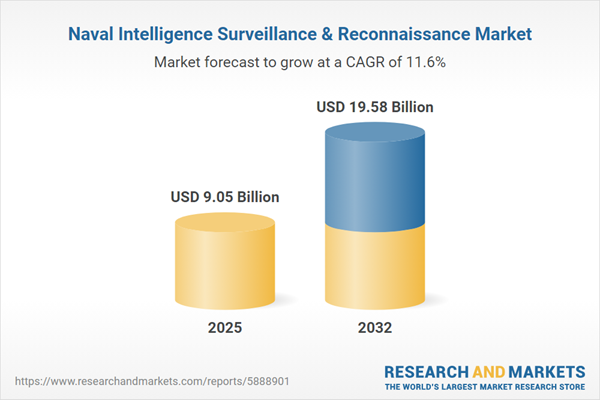Speak directly to the analyst to clarify any post sales queries you may have.
The naval intelligence surveillance and reconnaissance (ISR) market is evolving as maritime organizations prioritize integrated, adaptable solutions to address escalating security challenges and operational complexity. Senior leadership is refocusing strategy to ensure efficient, secure flow of information and greater maritime situational awareness.
Market Snapshot: Naval Intelligence Surveillance & Reconnaissance (ISR) Market
The Naval Intelligence Surveillance & Reconnaissance (ISR) Market is positioned for significant growth, as its value is set to rise from USD 8.11 billion in 2024 to USD 9.05 billion by 2025, achieving a compound annual growth rate (CAGR) of 11.64%. Forward-looking projections indicate continued expansion, with estimates placing the market at USD 19.58 billion by 2032.
Key drivers shaping this trajectory include advances in scalable acquisition, secure analytics, and modular intelligence systems that address the increasing complexity of maritime security requirements. Modern ISR system architectures are built for resilience and are equipping naval organizations to adapt strategically to shifting mission objectives and operational needs.Scope & Segmentation of the Naval ISR Market
- Platform Types: Naval ISR solutions span manned and unmanned platforms, including fixed wing and rotary aircraft, surface ships, sub-surface vessels, remotely operated vehicles, and ship-based EO/IR systems. Each platform contributes to operational agility and the ability to respond effectively in surveillance, detection, and maritime domain awareness operations.
- Intelligence Types: The sector delivers capabilities in communications, electronic, and signals intelligence. Critical functionalities include electromagnetic spectrum monitoring, EO/IR (electro-optical/infrared) imaging, radar, acoustic sensing, and chemical detection to build comprehensive situational understanding for naval missions.
- Sensor Technologies: Integrated systems comprise phased array radar, synthetic aperture radar, electronic countermeasures, active and passive sonar, shortwave and thermal EO/IR, and LIDAR. These technologies support precision identification and rapid response in demanding operational environments.
- Application Areas: Solutions cover a wide range, including maritime surveillance, precision mapping, electronic targeting, persistent tracking, and reconnaissance. This enables consistent monitoring and enhanced mission response day and night, supporting both defense and security goals.
- End Users: Defense agencies, naval forces, coast guards, research providers, and defense contractors leverage modular, upgrade-ready ISR systems that adapt to diverse procurement needs and operational priorities.
- Regional Coverage: The market spans key territories in the Americas—driven by momentum in the United States and Brazil—EMEA regions such as the UK, France, and UAE, and leading Asia-Pacific countries including China, India, and Australia. Adoption timelines and collaboration priorities vary, influenced by regional security policies and strategic focus.
- Key Companies: Major participants are Lockheed Martin, Northrop Grumman, Raytheon Technologies, BAE Systems, L3Harris Technologies, General Dynamics, The Boeing Company, Thales, Leidos Holdings, and Science Applications International Corporation. These providers deliver customized solutions to address evolving mission profiles and emerging requirements.
Key Takeaways: Strategic Insights for Naval ISR Decision-Makers
- Next-generation ISR systems enhance operational awareness, supporting leaders with real-time response capabilities to address multi-layered maritime threats.
- Seamless integration of autonomous assets and advanced sensor fusion facilitates collaborative operations and smooth transitions between single-agency and joint agency missions.
- Flexible, modular architectures allow for technology upgrades, supporting continuous adaptation as national and international compliance standards evolve.
- Standardized interoperability protocols strengthen secure data exchange between coalition or allied partners, promoting coordinated approaches in multinational operations.
- Focused collaboration with research entities and field operators promotes accelerated implementation of relevant ISR technologies as operational needs change.
- User-centric development practices optimize procurement cycles and extend platform lifespans, accommodating shifting operational demands and investment considerations.
Tariff Impact on Naval ISR Ecosystems
U.S. tariffs on essential ISR components—ranging from electronic sensors to unmanned systems and specialty subsystems—have prompted suppliers to adjust their sourcing and manufacturing approaches. Companies are increasing domestic production, forming global joint ventures, and updating procurement strategies to stabilize supply chains. These adjustments help ensure continued regulatory compliance and maintain the agility demanded in a dynamic trade landscape.
Methodology & Data Sources
This analysis is grounded in structured executive interviews, in-depth technical reviews, and verified open-source intelligence. By benchmarking both deployment and supply chain resilience, the methodology generates actionable insights for procurement leaders and guides effective investment allocation.
Why This Report Matters
- Provides leadership with up-to-date market intelligence, supporting informed decisions on investments and acquisitions in the naval ISR landscape.
- Clarifies evolving patterns in technology adoption and market segmentation, empowering organizations to plan modernization initiatives with confidence.
- Presents reliable performance and supply chain benchmarks to help anticipate sector and regional shifts and adapt organizational strategies effectively.
Conclusion
This report equips senior leaders to navigate a transforming naval ISR market and maintain mission effectiveness as operational and security priorities evolve.
Additional Product Information:
- Purchase of this report includes 1 year online access with quarterly updates.
- This report can be updated on request. Please contact our Customer Experience team using the Ask a Question widget on our website.
Table of Contents
3. Executive Summary
4. Market Overview
7. Cumulative Impact of Artificial Intelligence 2025
Companies Mentioned
The companies profiled in this Naval Intelligence Surveillance & Reconnaissance market report include:- Lockheed Martin Corporation
- Northrop Grumman Corporation
- Raytheon Technologies Corporation
- BAE Systems plc
- L3Harris Technologies, Inc.
- General Dynamics Corporation
- The Boeing Company
- Thales S.A.
- Leidos Holdings, Inc.
- Science Applications International Corporation
Table Information
| Report Attribute | Details |
|---|---|
| No. of Pages | 187 |
| Published | October 2025 |
| Forecast Period | 2025 - 2032 |
| Estimated Market Value ( USD | $ 9.05 Billion |
| Forecasted Market Value ( USD | $ 19.58 Billion |
| Compound Annual Growth Rate | 11.6% |
| Regions Covered | Global |
| No. of Companies Mentioned | 10 |









